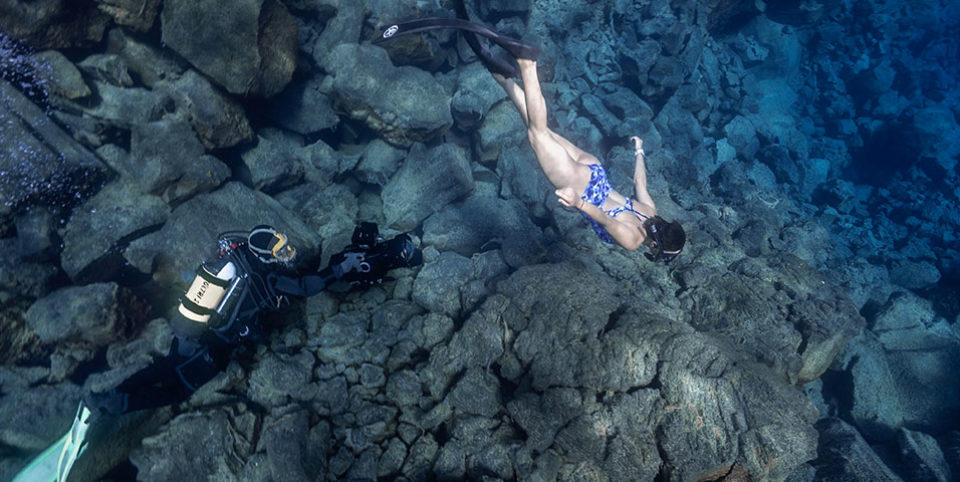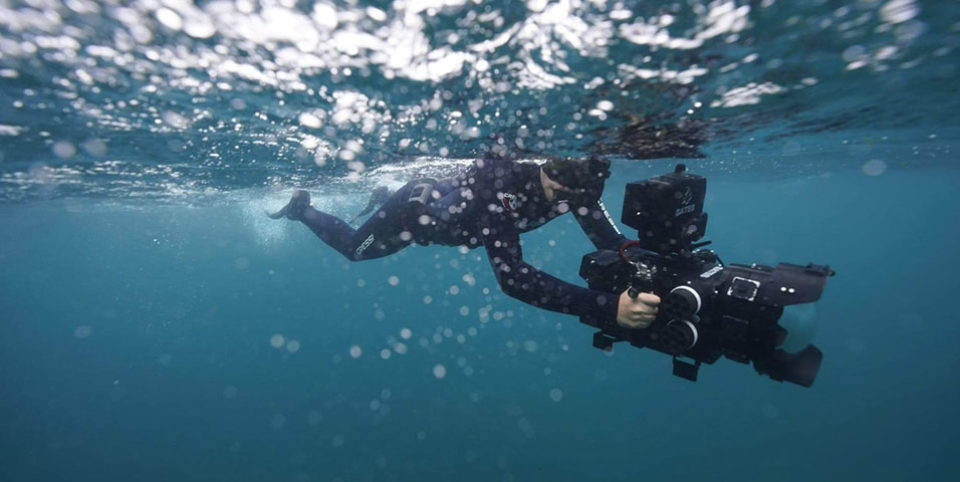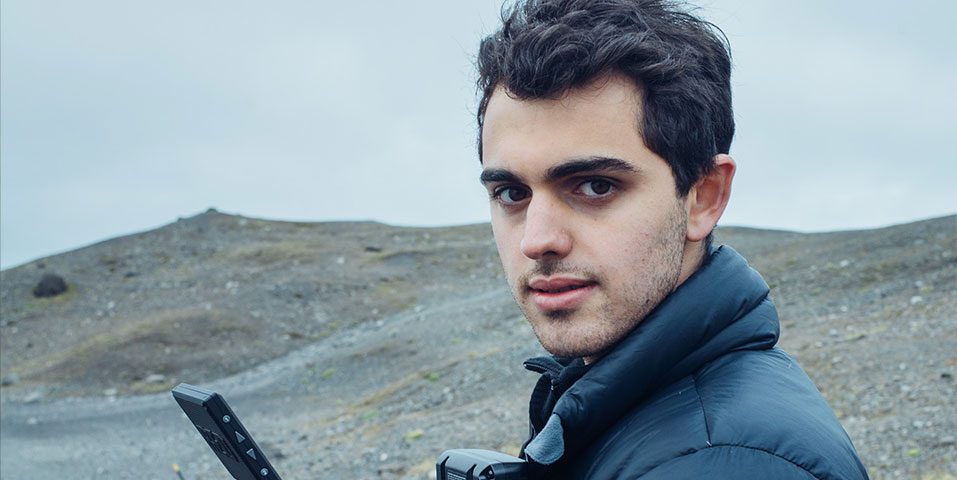Since graduating from the Bachelor of Arts Screen: Production program in 2018, Nays Baghai, the creative director of Running Cloud Productions, has been working as an independent filmmaker and underwater cameraman. Since the age of 14, he has won 20 awards for his short films, and has shot and edited content for dozens of Australian businesses in the corporate and diving sectors. He also holds numerous scuba diving and freediving certifications, and can dive up to 40 metres below the surface – both with and without tanks.
Somehow, between all of that, Nays has managed to complete his first feature film. Descent – a documentary about the psychology of ice freediver Kiki Bosch – is about to have its world premiere at Sydney Film Festival, and it’s already making waves. The film will be competing for the Documentary Australia Foundation Award for Best Australian Documentary, which carries a $10,000 cash prize, alongside nine other finalists (five of which also feature the work of AFTRS alumni). Ahead of the premiere, AFTRS’ Melba Proestos sat down with Nays to discuss the origins of Descent, his adventures as an underwater cameraman, the challenges of filming and editing a diving documentary, and future plans for the project.

MELBA PROESTOS: Descent is quite the accomplishment – congratulations. How did you come by the story and why did you decide to tell it?
NAYS BAGHAI: My time at AFTRS actually played a significant role in the origin story of Descent. During the first year of the BA program, I was collaborating with my classmate Jami Blood on a short film that required me to dive down on one breath to get the underwater shots she needed. The experience was really quite an epiphany: it convinced me that diving and filmmaking were what I wanted to do with my life. To complement my “dry” studies at AFTRS, I took as many courses in freediving and scuba diving as I could in my free time. As I started diving in deeper, colder and murkier waters within Sydney, all my non-diver friends began asking me, “Why do you do it?!” That question really resonated with me, but my growing network of professional divers who dive even deeper made an even bigger impact. When I met ice freediver Kiki Bosch, I learned about her story of overcoming the trauma of rape through the power of cold water immersion. It inspired me to finally crystallise the concept of my next project – a documentary series about the psychology of people who specialise in challenging underwater environments.
MP: So, you were dealing with sensitive material and complicated execution. How did you go from concept to creation?
NB: From the beginning, I knew I wanted to go in the opposite direction of previous documentaries about the underwater world. Instead of doing an epic, adrenaline-fuelled style of storytelling, I wanted to take a more character-driven, psychological approach in order to depict these individuals more authentically and sensitively. I was fortunate that the remaining year I had at AFTRS included a wide variety of assignments that allowed me to flesh out my ideas in greater detail. Some of these included style bibles, proof of concept trailers, production strategies, pitch sessions, acting exercises and at the end of my third and final year, writing the 40-page scripts of the first two episodes. To get the full series green-lit, I shifted my energy to independently producing a 60-minute piece on Kiki that could function both as the pilot and as a standalone film.

MP: I see a lot of familiar names in the credits. Many of them are from different years or different programs to you. How did you assemble your team?
NB: I began a friendship with Eero Heinonen (Master of Arts Screen, 2018) while working as an underwater cinematographer on his Masters film Escape By Sea. One day while having a post-screening coffee, I told him about Descent, and he asked if he could join me as a producer to make it happen. After getting my business partner Mehrdad Baghai on board, the three of us became an inseparable trio over the 16 months of production. Because we were travelling to four different countries on a very limited budget, we decided to work with local film and dive crews to help us with cinematography, sound recording and dive support. However, we also had two crew members who were students at AFTRS at the time – Geordie Brown (current Bachelor of Arts Screen student) and Ehran Edwards (Master of Arts Screen, 2019). Geordie joined the producing team in Sydney, and did a fantastic job of managing logistics and timekeeping while I could focus more on the artistry of each given scene. Ehran was the principal cinematographer for the New Zealand shoot and brought a really elegant, clean style of cinematography that was a real treat to watch in the editing room.
MP: With so many locations and constantly being at the mercy of the elements, you must have faced some serious hurdles. What were your biggest challenges and how did you overcome them?
NB: Shooting in cold water is one of the most difficult types of filming you can possibly do. Communication is limited, intense physical and mental stamina are required for the long days of diving, the diving and lighting conditions are constantly changing, and you’re in water that can be as low as 3°C. Because Kiki dives in just her swimsuit, we had to limit her time in the water to an absolute minimum so she wouldn’t get too cold. This was just one of the hundreds of safety precautions we mapped out long before the cameras started rolling. In New Zealand, my job as the director required me to continually freedive up and down to communicate with the scuba divers 15m+ deep, and then back up to Kiki, the safety divers and dry crew. It was definitely one of the most exhausting things I’ve ever done in my life, because of how much focus, physical energy and problem solving was required simultaneously while we were shooting in the near-freezing water. Editing was also a colossal challenge in its own right – I had about 150 hours of footage that amounted to 15 terabytes. I had five months to make the deadline and to cut it down to one hour while retaining a cohesive story. I worked alone from home the entire time, and I owe a lot to my friends for offering me invaluable feedback towards improving the edit.
MP: What’s next for you?
NB: My full-time job is now expanding Descent into a larger project beyond the feature film. All 12 characters have been optioned, and I’ve started conversations with potential backers, so it’s now a matter of being patient. I’ll also be writing a book about their stories in tandem, which I’m eagerly looking forward to as a storyteller. I’ve got a few other long and short-form projects on the horizon, but right now, it’s just a waiting game to see what happens with COVID19.
Watch Descent on the official streaming platform for this virtual edition of Sydney Film Festival, and find out more on the film’s website.
DESCENT CREDITS
Director: Nays Baghai (Bachelor of Arts Screen: Production, 2016)
Producers: Eero Heinonen (Master of Arts Screen, 2018; Advanced Diploma in Producing: Story, Audience, Finance, 2016), Nays Baghai, Mehrdad Baghai
Associate producer: Geordie Brown (Current Bachelor of Arts Screen student)
Cinematography: Eero Heinonen, Nays Baghai, Ehran Edwards (Master of Arts Screen, 2019), Stefan Andrews
Underwater cinematography: Teemu Liakka, Peter Lightowler (Diploma in Grading, 2017; Diploma in Editing Fundamentals, 2015), Nays Baghai
Editing: Nays Baghai
Music: Kailesh Reitmans
